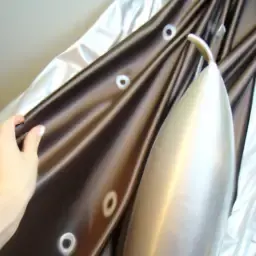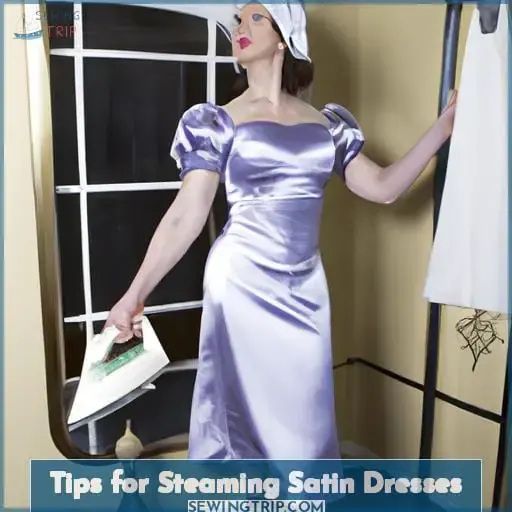This site is supported by our readers. We may earn a commission, at no cost to you, if you purchase through links.
Steaming a satin dress can be intimidating, but it doesn’t have to be. With the right tools and knowledge, you can easily steam your favorite garments like a pro! The process might seem daunting, but with guidance from experts like Gwen Whiting and Lindsey J. Boyd of The Laundress, you can confidently remove wrinkles without worry of ruining your fabrics.
Why is steaming important for natural fabrics like silk and cotton? How do you correctly use a steamer on delicate materials like satin? Tips on avoiding water spots or melting embellishments while using heat to press out creases. What to do if there’s an accident with spilled water.
So let’s get started!
Table Of Contents
Why Use a Steamer?

Steaming is an easy and efficient way to give your special dress the care it needs without damaging its delicate fabric. It’s important to keep safety in mind when steaming any garment, especially a satin dress which requires extra attention.
Before beginning, select the appropriate steamer for your task. Steamers are much safer than irons as they don’t require contact with the fabric while producing enough heat and humidity levels necessary for perfect results.
Ensure that you fill your steamer’s water tank with hot water, avoiding boiling temperatures. This will prevent scalding delicate fabrics like silk or satin.
As you go about using it, make sure the steam function stops before inserting any part of yourself into a garment. Otherwise, you risk severe burns.
Be sure no parts from the steamer head touch directly onto a satin dress during use. Otherwise, you risk melting precious details away completely!
How to Steam a Satin Dress

Fill your steamer with fresh water and let it heat up. Hang the dress on a hanger.
Start steaming from top to bottom in long strokes. Focus on problem areas such as cuffs or collars that need extra attention.
Let the garment dry completely for several minutes after finishing steaming.
You can steam a satin dress like a pro with these easy steps. Keep your dresses looking their best!
Step 1: Prepare Your Steamer
Before you begin, make sure your steamer is ready to go: fill its water tank with hot water and ensure the steam function shuts off before inserting any part of yourself into a garment. To avoid flea market disasters, it’s important to know the basics of ironing fabrics for care. Before steaming that satin dress for an event or special occasion, take some fabric care tips from experts like Gwen Whiting and Lindsey J. Boyd. They suggest using a shower rod and pressing cloths instead of directly applying heat on delicate garments like silks and wools. You can also use distilled water in your spray bottle if necessary to help reduce creasing on hard-to-iron pieces or those prone to wrinkles, like cotton blends. They need extra moisture during ironing sessions, but require more attention than most! When approaching the task, hold your steamer six inches away from the clothing item and make downward strokes with continuous motion until all desired areas are free from creases. Hang it up immediately after! Clothing storage solutions should always include keeping items flat so they won’t wrinkle again. But following these expert tips will ensure your clothes look their best without much effort!
Step 2: Hang Your Dress
Now that you’ve given your dress a beautiful touch of steam, hang it up and admire the stunning result – it’s sure to be a showstopper! Ironing techniques are essential for satin fabric as this delicate material is prone to wrinkles. To avoid damage, always select an iron with adjustable temperature settings and adjust the length according to the type of fabric.
Cleaning tips should also be taken into consideration before steaming; dirt particles may cause permanent stains on satin dresses if not removed properly beforehand. For better results, professional assistance can be hired from Susan Stocker Runs Outstanding Customer Service Protocols Better Business Torch Award Winners who specialize in handling such materials with utmost care.
When hanging up your dress after steaming, make sure there’s enough space between you and the steamer so no water spots appear due to too much heat or moisture exposure.
Step 3: Steam the Dress
Now it’s time to make your dress come alive – give it a gentle touch of heat and watch as the wrinkles magically disappear! To steam a satin dress, you need to use ironing techniques that will protect delicate fabrics. Reverse steaming is important when tackling wrinkle removal on these types of garments. Proper temperature control with fabric care in mind is essential for successful steaming results. Use either a garment steamer or steam iron depending on what was recommended by the manufacturer, keeping in mind that garment steamers are usually better for delicate items like silk satin and result in lower dry cleaning bills over time.
Follow all safety instructions before starting any process involving heat so you don’t end up damaging your precious piece!
Here are some tips for how to properly steam:
- Start at the top of your dress and slowly move down using short bursts from an arms-length away while controlling temperatures accordingly
- Make sure not too much water comes into contact with the fabric – keep some distance between them
- Wipe off excess condensation afterwards with lint free cloths
Step 4: Focus on Problem Areas
Once you’ve steamed your dress, zap any stubborn wrinkles with careful precision to make it look perfect – just like a real-life time machine! To repair creases and prevent stretching, focus on the surface of the fabric with a free hand. Avoid using an iron, as it can cause irreversible damage to satin dresses. As an alternative, use your steam cleaner set at its lowest heat setting and fill it up with fresh, clean water each time before use.
Carefully move over each area of the garment for steam to permeate through all layers – don’t forget about tricky areas such as pleats or gathers! If needed, go back over problem areas more than once until they are smooth again.
Following these tips will ensure you get wrinkle-free results without damaging delicate fabrics!
Step 5: Let the Dress Dry
After you’ve steamed your dress to perfection, hang it up and let the fabric air dry for a beautiful, wrinkle-free finish! Ironing temperatures should be adjusted depending on the fabric type. Wrinkle removal is most effective with a garment steamer – it involves less contact with heat than ironing does.
Fabric care should include proper maintenance of your steamer – use only non-distilled water to prevent mineral buildup that could damage clothing over time. Especially delicate fabrics like satin should be treated from top to bottom; this also applies to wedding dresses, which often contain rhinestones or other decorations glued onto them and can easily melt if exposed directly to steam jets at too high temperatures.
A great way of preventing any potential damages is to keep some distance between the nozzle and fabric while applying steam, so no spots will remain afterwards.
Tips for Steaming Satin Dresses
To achieve a smooth, wrinkle-free look for your delicate satin dress, follow these tips for steaming like an expert. Satin clothing needs special attention when it comes to care and cleaning. Ironing techniques should be avoided as they can damage the fabric’s sheen and texture. Steaming is a gentle way of removing wrinkles without compromising its quality.
Always use distilled water to avoid hard water stains or mineral buildup that may affect its appearance over time. Fill up your steamer with fresh water each time you steam to ensure good results. Hang up your garment in front of you before starting so that it remains in good shape while being exposed to heat and moisture from the burst of steam.
Cover any embellishments with a cloth or towel before applying steam directly onto them. Avoid using harsh detergents or bleach products on satin dresses. Use mild soap solutions instead such as dishwashing liquid mixed with lukewarm water for spot cleaning.
By following this complete step-by-step process along with these tips, you’ll have successfully steamed your satin dress back into perfect condition! Don’t let those pesky wrinkles get in the way anymore – give it a quick run through some warm vapor today!
What to Do if Water Drops on Your Garment?
If water drops on your garment while steaming, quickly wipe it off with a dry cloth to prevent any damage. To ensure you don’t get stains or creases, here are some tips for ironing delicate fabrics like satin:
Fill the water tank of your steamer or iron with fresh cold water only; never use stale or hot water as this can cause discoloration and odors.
Place a white cotton cloth between the fabric and the steam nozzle to protect from direct contact when using an iron instead of a steamer; move slowly along each section so no moisture is left behind.
Control temperature settings according to the fabric’s needs; low setting for silk garments like satin blouses or shirts, medium-low heat for linen items, etc. Ironing at too high temperatures might melt synthetic fibers found in many clothing items.
Use short bursts of steam rather than long ones – this way you’ll get better wrinkle removal results without damaging delicate materials.
Before starting, read label instructions closely, pre-treat hard-to-remove stains if needed, then hang the item onto a hanger while working sections one by one until it’s totally finished.
Taking all necessary precautions will help keep clothes looking their best – follow Studio Heijne’s video tutorial (or step-by-step directions) next time you want to refresh a favorite outfit quickly and easily.
Frequently Asked Questions (FAQs)
What type of steamer is best for satin dresses?
When it comes to steaming satin garments, you want a steamer that offers precise temperature control and can provide the proper care needed to handle wrinkles. Susan’s Green Cleaning recommends The Steamery Cirrus No 2, specifically designed for fabric care. It’s capable of delivering powerful steam while providing consistent heat distribution.
Standing garment steamers are best for polyester satin garments, such as silk or pajamas, as they allow you to adjust the duration of your steaming and have more room in their tanks for garment storage.
Is it safe to steam a satin dress if it has embellishments?
It’s important to be cautious when steaming a satin dress with embellishments. Fill the steamer tank with fresh water before using it. Keep some distance between the surface of your satin garment and the nozzle, so as not to burn or discolor any fabric components. Sequins, crystals, etc. may melt due to direct heat of an iron or a steamer at too close proximity. Take extra caution, for long-lasting results.
Can I steam a satin dress while it is still on the hanger?
Yes, you can steam a satin dress while it’s still on the hanger. Use a Susan’s Green Cleaning Steam Wand with two feet of distance from the fabric. Adjust your wand depending on the fabric’s fibers. Start at the top and work downward, using slow strokes. This allows time for heat transfer without too much contact with embellishments or hardware. Hang the dress in front of an open window or near a hot shower after steaming. This helps dry out any residual moisture left behind by steam.
Are there any particular precautions I should take when steaming a satin dress?
When steaming a satin dress, it’s important to take precautions. Start by using the appropriate fabric care and dyeing instructions on the label for guidance – this should include ironing techniques and steam settings. Use a thin cotton press cloth between the garment and your hand when applying steam with an iron or steamer, as direct contact can cause burns.
For delicate fabrics like satin use low heat setting with continuous stream of steam while holding 6 inches away from fabric surface; avoid dry cleaning if possible as repeated cycles may damage fibers over time.
You can also add some white vinegar to water in order to help reduce static cling or any yellow discoloration that might occur due to overheating of fabric during steaming process.
What is the difference between steaming and ironing a satin dress?
Steaming and ironing a satin dress have some similarities, but they differ in the amount of wrinkles prevention, temperature control, fabric care and garment storage.
When steaming with a steamer wand from The Steamery or any other brand you can save time and gently remove wrinkles. Watch a short video made by Studio Heijne on how to steam silk garments or follow step-by-step instructions.
Ironing your silken garments should only be done when necessary as using wrong temperatures may cause damage. If absolutely needed, make sure most of the heat goes into the larger parts of the dress, not embellishments or hardware which could melt due to higher temperatures.
Take proper steps for each method to ensure a gentle way to wrinkle-free dresses!
Conclusion
You’ve now learned how to steam a satin dress like a pro. To get the best results, make sure to follow the steps carefully and use the right equipment. With a bit of patience and practice, you’ll be able to keep your satin garments looking perfect.
If you ever run into a snag, don’t worry—just take a deep breath and try again. After all, practice makes perfect.
With the right knowledge and the right tools, you can steam your way to a wrinkle-free wardrobe in no time. So don’t be afraid to give steaming a try—it’s like a walk in the park!








